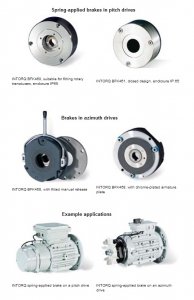
Six Intorq brakes.
The requirements for pitch and yaw brakes include high reliability, long maintenance cycles, resistance to environmental influences, and a tight braking-torque tolerance. For pitch drives, one brake manufacturer has developed spring loaded devices as holding brakes that have to perform in a particular way in emergencies, even after a failure. The brake casing is encapsulated. Yaw drives use brakes from the company’s modular BFK458 series. In the event of a fault, the brakes act as a friction clutch to let the nacelle move with the wind. Offshore duty calls for high corrosion protection and durability. Encapsulated versions with special surface protection are used there.
Example applications also include spring-applied brakes in pitch drives.
A bridge/half-wave rectifier has proven useful. After a period, the bridge/half-wave rectifiers switch over from bridge rectification to half-wave rectification. Depending on design, over-excitation or holding current reduction or both, it is possible to shorten the switching times or reduce self-heating (power reduction).
Company engineers have modified the insulation for this area of use and stored-spring brakes without partial discharge can be supplied as an option. The advantages of over-excitation and reduction of the holding current can be combined with each other in this case.

The image provides some explanation as to how the bridge/half-wave rectification functions and how reducing the holding voltage and over-excitation behaves when selecting a suitable coil voltage. When stored-spring brakes are operated from the DC link of a frequency inverter with pulse width modulation, partial discharge can occur and damage the coil system.
Intorq US Inc.
Filed Under: News, Pitch & yaw





How well do the pitch and yaw brakes hold up to the elements over time. Does the extra surface protection on the brakes need to be reapplied after a certain amount of time? What is the durability of the coating used on offshore applications and the maintenance required? http://buildsitepro.com/home.asp